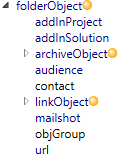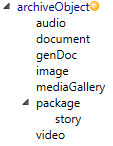Short guide to frequently used objects
The standard GN4 schema contains a high number of objects, whereas some of them are used more frequently than others, and thus described in this topic. Have in mind that the GN4 schema is hierarchical, and so all objects have a "parent" (the object one level higher), and some also have "children" (objects in sub-levels).
object is parent of all other objects. |
folderObject contains the content that get stored in folders, e.g. in the first place all the members of archiveObject and linkObject and others.
The members are: •linkObject: its children can be linked to a paper page, and include article, img and txt objects. •archiveObject: its children cannot be linked to a paper page, but can arrive via wire or manual upload, and can be stored in the Tark4 archive. Such objects include audio, video, image, package with its only child story,and document objects. •url: a Web address object. •contact: an address book object. •objGroup: a special object to group other objects. •other special objects |
archiveObject contains the wires and archived content, namely image, video, audio, mediaGallery, document and package (that in turn contain a story object).
|
The paper publishing related objects are tied to managing of the paper pages. These are: •edition: contains pages and page layers •editionNumber: related to an edition, and describes it as 'first', 'second' etc. •layer: contains page objects such as frames, boxes etc. •page: contains page layers. •pagePreview: the page bitmap that appears in various listings. •tracyLayout: the list of pages to be tracked down. |
The Web/channels publishing related objects are: •pubDest: a general container of published object (excluded the paper products). •pubMode: additional qualifier of the content published on pubDest, e.g. position on Web page. •pubTemplate: specify rules for the publishing in all associated pubDests. |
Other content related objects interact in some way with content objects. These are: •archive: can store temporarily some objects. The name as appears in the user interface is Collection. •category, categorySet and keywordSet: used for content classification •variantType: contains variations of binary objects, such as audio, image, video, document etc. |
The work organizing related objects serve to contain special content related to organizing the newsroom work. Some of these objects may be stored in a calendar, such as events and tasks, so they are children of the calendarObject: •event: contains information about an event to cover potentially. •task: contains information about tasks to perform to provide/organize content for publishing. Some similar objects are not stored in calendars, but they derive directly from the root object, and these are: •budget: it is a detailed plan of an edition (not including advertisement) •calendar: it is the storage for event and task objects. |
All other objects are related to the various aspects of the system configuring. |
•archiveObject (member of folderObject, contains audio, document, image, package > story, video) •article (member of linkObject) •audio (member of archiveObject) •calendarObject (contains event and task) •document (member of archiveObject) •edition •editionNumber •folderObject •font •fontLayout •geometry •hyphenation •image (member of archiveObject) •img (member of linkObject) •justContext •justDef •justScope •layerType •lib •libObj (member of layer) •linkObject (member of folderObject, contains article, img, txt) •master (member of layer) •media •page •pageLayer •printConfig •pubDest •region •section •story (member of archiveObject) •title (member of publication < publicationBase) •txt (member of linkObject) •txtGeometry •url •zone |


